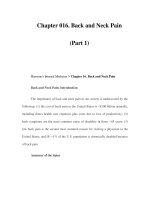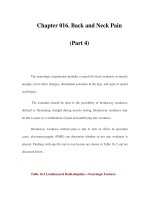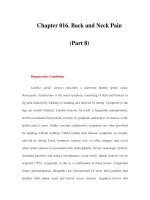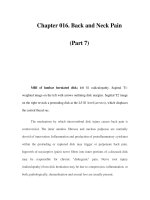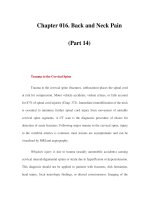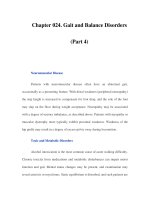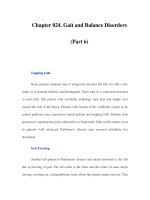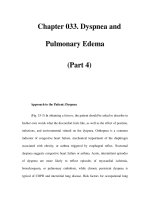Chapter 131. Diphtheria and Other Infections Caused by Corynebacteria and Related Species (Part 4) ppsx
Bạn đang xem bản rút gọn của tài liệu. Xem và tải ngay bản đầy đủ của tài liệu tại đây (39.82 KB, 5 trang )
Chapter 131. Diphtheria and Other Infections Caused by
Corynebacteria and Related Species
(Part 4)
Diagnosis
The diagnosis of diphtheria is based on clinical signs and symptoms plus
laboratory confirmation. Respiratory diphtheria should be considered in patients
with sore throat, pharyngeal exudates, and fever. Other symptoms may include
hoarseness, stridor, or palatal paralysis. The presence of a pseudomembrane
should prompt consideration of diphtheria. Once a clinical diagnosis of diphtheria
is made, diphtheria antitoxin should be administered as soon as possible.
Laboratory diagnosis is based either on cultivation of C. diphtheriae or
toxigenic C. ulcerans from the site of infection or on the demonstration of local
lesions with characteristic histopathology. C. pseudodiphtheriticum, a
nontoxigenic organism, is a common component of the normal throat flora and
does not pose a significant risk. Throat samples should be submitted to the
laboratory for culture with the notation that diphtheria is being considered. This
information should prompt cultivation on special selective medium and
subsequent biochemical testing to differentiate C. diphtheriae from other
nasopharyngeal commensal corynebacteria. All laboratory isolates of C.
diphtheriae, including nontoxigenic strains, should be submitted to the CDC.
A diagnosis of cutaneous diphtheria requires laboratory confirmation since
the lesions are not characteristic and are clinically indistinguishable from other
dermatoses. Diphtheritic ulcers occasionally—but not consistently—have a
punched-out appearance (Fig. 131-2). Patients in whom cutaneous diphtheria is
identified should have the nasopharynx cultured for C. diphtheriae. The laboratory
media for cutaneous diphtheria are the same as those used for respiratory
diphtheria: Löffler's or Tinsdale's selective medium in addition to nonselective
medium such as blood agar. As has been mentioned, respiratory diphtheria
remains a notifiable disease in the United States, whereas cutaneous diphtheria is
not.
Diphtheria: Treatment
Diphtheria Antitoxin
Prompt administration of diphtheria antitoxin is critical in the management
of respiratory diphtheria. The antitoxin—a horse antiserum—is effective in
reducing the extent of local disease as well as the risk of complications of
myocarditis and neuropathy. Rapid institution of antitoxin therapy is also
associated with a significant reduction in mortality risk. Because diphtheria
antitoxin cannot neutralize cell-bound toxin, prompt initiation is important. This
product, which is no longer made commercially in the United States, is available
from the CDC under an investigational new drug protocol and may be obtained by
calling the Bacterial Vaccine Preventable Disease Branch of the National
Immunization Program at 404-639-8257 between 8:00 A.M. and 4:30 P.M. U.S.
Eastern time or at 770-488-7100 at other hours; the relevant website is
The current protocol for the use
of antitoxin includes a test dose to rule out immediate-type hypersensitivity.
Patients who exhibit hypersensitivity require desensitization before a full
therapeutic dose of antitoxin is administered.
Antimicrobial Therapy
Antibiotics are used in the management of diphtheria primarily to prevent
transmission to other susceptible contacts. Recommended options for the treatment
of patients with respiratory diphtheria are as follows: (1) procaine penicillin G at a
dosage of 600,000 units (for children, 12,500–25,000 U/kg) IM every 12 h until
the patient can swallow comfortably, after which oral penicillin V is given at 125–
250 mg four times daily to complete a 14-day course; or (2) erythromycin at a
dosage of 500 mg IV every 6 h (for children, 40–50 mg/kg per day IV in two or
four divided doses) until the patient can swallow comfortably, after which 500 mg
is given PO four times daily to complete a 14-day course.
A clinical study in Vietnam found that penicillin was associated with a
more rapid resolution of fever and a lower rate of bacterial resistance than
erythromycin; however, relapses were more common with penicillin.
Erythromycin therapy targets protein synthesis and thus offers the presumed
benefit of stopping toxin synthesis more quickly than a cell wall–active β-lactam
agent. Alternative agents for patients who are allergic to penicillin or cannot take
erythromycin include rifampin and clindamycin. Eradication of C. diphtheriae
should be documented at least 1 day after antimicrobial therapy is complete. A
repeat throat culture 2 weeks later is recommended. For patients in whom the
organism is not eradicated after a 14-day course of erythromycin or penicillin, an
additional 10-day course followed by repeat culture is recommended.
Cutaneous diphtheria should be treated as described above for respiratory
disease. Individuals infected with toxigenic strains should receive antitoxin. It is
important to treat the underlying cause of the dermatoses in addition to the
superinfection with C. diphtheriae.
Patients who recover from respiratory or cutaneous diphtheria should have
antitoxin levels measured. If diphtheria antitoxin has been administered, this test
should be performed 6 months later. Patients who recover from respiratory or
cutaneous diphtheria should receive the appropriate vaccine (see "Prevention,"
below) to ensure the development of protective antibody titers, which does not
occur in all cases.
